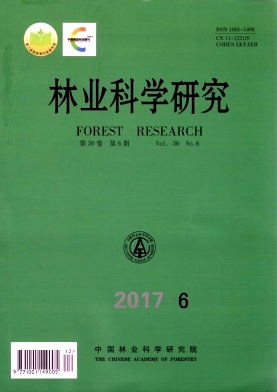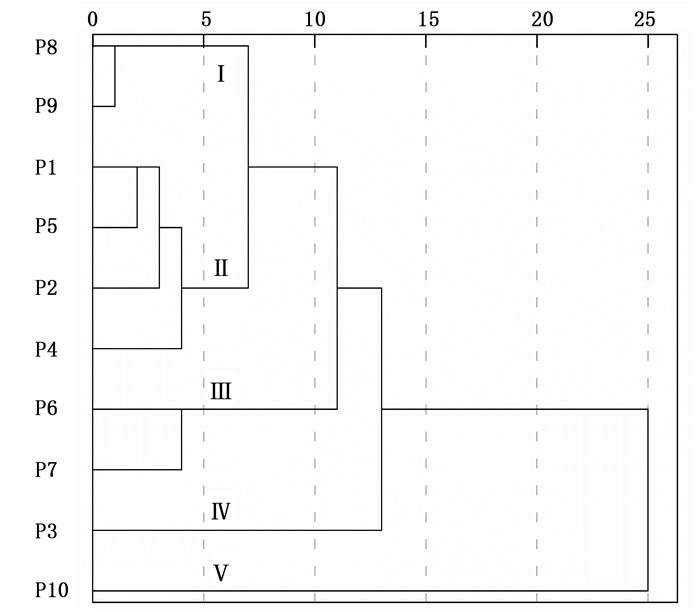-
西伯利亚杏(Armeniaca sibirica (L.) Lam.)为蔷薇科李亚科杏属植物[1],在我国主要分布于内蒙古、辽宁等省区的低山丘陵和灌木草原上,抗逆性强,是抗旱、抗寒(可低至-35℃)、抗风沙的“先锋”树种[2]。同时,西伯利亚杏也具有极高的附加价值,其中杏仁富含脂肪酸(45.64%)、蛋白质(28%)、苦杏仁苷(4.5%)[3]、维生素、无机盐、膳食纤维及人体所需的微量元素,是重要的木本油料树种和植物蛋白资源,西伯利亚杏种植是内蒙古地区防风固沙、脱贫致富的重要产业之一。西伯利亚杏多处于野生半野生状态,生产上缺乏良种,目前对西伯利亚杏的研究多集中在表型性状变异[4]、生殖生态[5]、油成分[6]、蛋白功能特性[7]、抗寒性[8]等方面。在优株选育方面,有专家对辽西[9]和庆阳[10]地区进行了晚花、丰产优株选择,对于苦杏仁主产区内蒙古的种质资源缺少全面系统的研究。
植物表型变异是基因表达和所处环境交互作用的结果,研究表型变异格局及其与地理生态因子的关系,有助于了解遗传因素和环境因素在植物生态适应中的相互作用[11]。本研究以西伯利亚杏优良单株为选择目标,以内蒙古地区10个种源为研究对象,结合地理生态因子对核仁表型和成分性状的变异规律进行研究,应用主成分分析法评选不同育种方向的优良单株,为西伯利亚杏仁用定向良种选育工作提供基础。
HTML
-
试验材料取自内蒙古林木良种繁育中心,中心收集保存了来自内蒙古各地的西伯利亚杏资源(采集优树种子播种繁殖),结合单株产量高、生长势好等指标筛选出217株初选单株为材料,种源地和单株数量见表 1。于果实成熟的7—8月份对试验材料进行采集测定,每1单株从东西南北4个方向随机采摘健康、无病虫害的果实40个,低温保鲜带回实验室用于测量核形态、仁形态和仁成分,采全树果实测算产仁量(仁干质量)。
种群
Population数量
Number编号
Population ID纬度
Latitude (N)经度
Longitude(E)年平均气温AMAT/℃ 年日照时数
AMSD/h海拔
Altitude/ m年降水量
AP/mm无霜期
Frost-free days/d科左后旗HLRB 18 P1 43.62° 122.58° 5.8 2 889 308 452 148 巴林右旗BRB 23 P2 43.52° 118.65° 4.9 2 882 1 100 358 121 扎赉特旗JLB 6 P3 47.35° 123.63° 3.4 3 000 362 400 125 科右中旗HRMB 13 P4 45.08° 112.78° 6.3 2 900 876 355 122 察尔森镇CT 11 P5 46.20° 122.05° 3.9 3 100 686 485 120 扎鲁特旗JUB 30 P6 44.92° 121.45° 6.6 2 883 224 380 130 万家沟WJG 27 P7 40.68° 111.15° 5.9 2 872 1 050 400 157 敖汉旗AHB 9 P8 42.03° 119.87° 6.1 2 800 575 407 140 凉城县LC 24 P9 40.52° 112.48° 5.0 2 900 1 400 400 120 和林格尔县HC 56 P10 40.38° 111.82° 6.2 2 942 1 160 393 118 Notes: AMAT, annual mean air temperature; AMSD, annual mean sunshine duration; AP, annual precipitation; AHB, Aohan Banner; BRB, Bairin Right Banner; CT, Charlson town; HC, Horinger County; HLRB, Horqin Left Rear Banner; HRMB, Horqin Right Wing Middle Banner; JLB, Jalaid Banner; JUB, Jarud Banner; LC, Liangcheng County; WJG, Tumotezuoqi Wanjiagou. Table 1. Geographical locations and main climatic conditions for 10 Armeniaca sibirica populations
-
参照《杏种质资源描述规范和数据标准》[12]和《中国果树志: 杏卷》[13]选择与经济特性紧密相关的16个表型性状。用电子天平精确到0.01 g测核干质量、仁干质量,用游标卡尺精确到0.01 mm测核纵径、核横径、核侧径、核壳厚、仁纵径、仁横径、仁侧径。根据核的纵径、横径,仁的纵径、横径分别计算核形指数和仁形指数。根据核干质量和仁干质量计算出仁率。用电子秤精确到0.1 g测量单株仁干质量得到产仁量。粗蛋白含量参照GB/T14772-2008方法,取0.3 g研磨后杏仁样品,加2 g催化剂(硫酸铜与硫酸钾1∶30混匀)和7 mL浓硫酸,用消化炉(上海瑞正仪器设备有限公司)消化1 h后冷却定容至50 mL得到样液,再利用SEAL AutoAnalyzer3流动注射分析仪进行测定;粗脂肪含量参照GB/T17377-2008方法,利用索氏提取装置(欣维尔公司)测定,称取一定量种仁于滤纸筒中,包好后置于索氏提取器,并加入适量石油醚(30~60℃),加热抽提,抽提至提取器内的石油醚用玻璃片检查点滴实验无油迹为止。然后旋转蒸发仪回收乙醚,抽提瓶于105℃干燥以除去残余的石油醚,冷却后即得油样;苦杏仁苷含量利用高效液相色谱仪Shimadzu LC-20AD来测定[3],色谱柱:Hypersil C18 (4.6 mm×250 mm,5 μm),柱温:40 ℃,紫外吸收检测器检测波长:210 nm色谱条件;流动相:甲醇∶乙腈∶水∶冰醋酸=1∶1∶16∶0.02流速:0.8 mL·min-1;在以上色谱条件下苦杏仁苷峰与相邻组分色谱峰得到完全分离,理论板数按苦杏仁苷色谱峰计算(柱长150 mm)。成分测定均进行3次重复。
数据处理在Excel 2010中完成,方差分析、多重比较、相关分析、聚类分析、主成分分析等都在SPSS 20.0软件中完成。
1.1. 材料来源和样品采集
1.2. 核、仁形态性状及仁成分的测定
-
西伯利亚杏核、仁的形态和仁主要成分的特征状况见表 2,对16个核、仁性状进行多样性分析的结果表明,西伯利亚杏核、仁性状的平均变异系数为18.63%,各性状的变化范围为8.94%~68.27%。其中产仁量的变异系数(68.27%)最大,各单株产量变化在27.84~854.41 g之间,其次为核壳厚(31.26%)、核干质量(27.11%)和仁干质量(21.50%),变异系数均大于20%;仁形指数的变异系数(8.94%)最小,变化在0.97~1.57之间,其次为核形指数(9.02%)、粗脂肪(9.12%),变异系数均小于10%;仁成分中粗蛋白(18.08%)和苦杏仁苷(16.63%)的变异系数较大而粗脂肪变异系数(9.12%)较小。核形态的变异系数(16.87%)大于仁形态的变异系数(14.14%),而仁成分的变异系数(14.61%)与仁形态相近。综上所述,西伯利亚杏产仁量、核干质量、仁干质量、出仁率、仁成分等主要经济性状变异丰富,具有较大选择潜力。
性状Traits 均值
Mean标准差
SD极小值
MIN极大值
MAX极差
Range变异系数
CV/%变异系数均值
Mean CV /%核纵径NVD /mm 17.37 2.08 10.02 24.46 14.44 11.96 16.87 核横径NHD /mm 15.72 1.81 11.20 22.24 11.04 11.54 核侧径NSD /mm 9.66 1.00 7.29 16.34 9.05 10.35 核壳厚ST /mm 1.06 0.33 0.40 2.05 1.65 31.26 核形指数NSI 1.12 0.10 0.86 1.44 0.58 9.02 核干质量NDM /g 0.90 0.25 0.45 2.00 1.55 27.11 仁纵径KVD /mm 12.64 1.41 7.10 16.82 9.72 11.14 14.14 仁横径KHD /mm 10.26 1.13 6.54 13.59 7.05 11.06 仁侧径KSD /mm 6.33 0.82 4.42 9.13 4.71 13.00 仁形指数KSI 1.24 0.11 0.97 1.57 0.60 8.94 仁干质量KDM /g 0.35 0.08 0.20 0.67 0.47 21.50 出仁率KR/% 39.76 7.62 20.16 56.99 36.83 19.17 产仁量KY/g 257.89 176.07 27.84 854.41 826.57 68.27 - 粗脂肪EE /% 48.70 4.44 29.32 57.65 28.33 9.12 14.61 粗蛋白CP /% 25.45 4.60 14.89 38.97 24.08 18.08 苦杏仁苷Nitrilosides /% 5.29 0.88 3.00 7.77 4.77 16.63 Notes: CP, crude protein; EE, ether extract; KDM, kernel dry mass; KHD, kernel horizontal diameter; KR, kernel rate; KSD, kernel side diameter; KSI, kernel shape index; KVD, kernel vertical diameter; KY, , kernel yield; NDM, nutlet dry mass; NHD, nutlet horizontal diameter; NSD, nutlet side diameter; NSI, nutlet shape index; NVD, nutlet vertical diameter; ST, sheel thickness; **, P<0.01. Table 2. Diversity of nutlet and kernel phenotypic traits of Armeniaca sibirica
-
表 3为西伯利亚杏的主要经济性状在10个种源间的变异分析。经F值检验,6个主要经济性状在种源间都存在极显著差异(P<0.01)。各性状的平均值、标准偏差和多重比较结果表明,仁干质量在种源间的变化在0.28~0.40 g之间,较大的是察尔森(P5)、敖汉旗(P8)、凉城(P9)种源;出仁率在种源间的变化在31.36%~46.72%之间,较大的是扎鲁特旗(P6)、科右中旗(P4)种源;产仁量在种源间的变化在115.17~276.46 g之间,最大的是敖汉旗(P8)种源;粗脂肪在种源间的变化在45.65%~51.47%之间,最大的是和林格尔县(P10)种源;粗蛋白在种源间的变化在20.93%~30.55%之间,最大的是察尔森(P5)种源;苦杏仁苷在种源间的变化在4.75%~5.96%之间,最大的是和林格尔县(P10) 种源。对10个种源用组间连接法进行聚类,得到聚类图(图 1),根据核、仁主要经济性状可以分为5类,第Ⅰ类群包含敖汉旗(P8)、凉城(P9)种源,特点是产仁量高、仁大;第Ⅱ类群包含科左后旗(P1)、察尔森(P5)、巴林右旗(P2)、科右中旗(P4)种源,特点是出仁率高,粗蛋白含量高;第Ⅲ类群包含扎鲁特旗(P6)、万家沟(P7)种源,特点是粗脂肪和苦杏仁苷含量高;第Ⅳ类群包含扎赉特旗(P3)种源,各项指标都较低;第Ⅴ类群为和林格尔县(P10),产仁量高、粗脂肪和苦杏仁苷含量高。
种群
Population仁干质量
KDM /g出仁率
KR /%产仁量
KY/g粗脂肪
EE /%粗蛋白
CP/%苦杏仁苷
Nitrilosides /%P1 0.35±0.08bc 39.76±4.26b 115.17±83.06a 47.48±3.72a 28.39±3.88de 4.99±0.73ab P2 0.36±0.05bc 41.02±5.53b 195.99±137.45ab 45.65±4.93a 28.41±3.47de 4.75±0.74a P3 0.28±0.06a 41.00±5.29b 131.97±79a 47.06±4.07a 23.35±2.16ab 4.75±1.11a P4 0.38±0.06bc 46.22±5.36c 164.72±106.68ab 48.48±2.84ab 27.35±3.64cd 4.9±0.81ab P5 0.4±0.1c 43.79±5.55bc 122.41±103.98a 45.96±3.32a 30.55±3.75e 5.03±0.67ab P6 0.33±0.08ab 46.72±5.34c 166.69±75.46ab 50.73±3.32bc 25.28±3.59bc 5.46±0.66bc P7 0.35±0.07bc 40.53±7.65b 184.48±116.32ab 50.99±2.97bc 22.77±3.71ab 5.49±0.61bc P8 0.4±0.08c 40.44±2.05b 276.46±5.56b 47.76±2.96a 26.6±2.86cd 5.3±0.74ab P9 0.4±0.1c 43.38±8.11bc 229.6±127.01ab 48.01±3.6a 26.6±4.42cd 5.35±0.93ab P10 0.32±0.06ab 31.36±5.48a 251.98±172.04ab 51.47±3.24c 20.93±2.84a 5.96±0.79c F值F value 4.338** 12.947** 2.672** 8.931** 18.620** 7.323** 注:种源编号见表 1。表型性状缩写见表 2。同列不同字母表示在0.05水平上差异显著。
Notes: See Table 1 for numbers of populations, Table 2 for abbreviations of phenotypic traits, and different letters in the same column indicated significant difference at 0.05 level.Table 3. The mean value, standard deviation and multiple comparison of nutlet and kernel traits of 10 Armeniaca sibirica populations

Figure 1. Clusterdendrogram of Armeniaca sibirica populations based on the nutlet and kernel traits (Population see Table 1)
-
表 4表明,西伯利亚杏6个主要经济性状与形态性状相关性较强。其中产仁量与核横径、核壳厚呈极显著正相关关系(P<0.01),与核干质量、核侧径、仁纵径、仁横径呈显著正相关关系(P<0.05);仁干质量与仁纵径、仁横径、仁侧径、核干质量、核纵径、核横径、核侧径呈极显著正相关关系(P<0.01);出仁率与仁干质量和仁侧径呈极显著正相关关系(P<0.01),与核纵径、核横径、核侧径、核干质量、核壳厚、仁纵径呈极显著负相关关系(P<0.01)。仁成分方面,粗脂肪与仁纵径、核纵径、核壳厚呈极显著正相关关系(P<0.01),与核侧径呈显著正相关关系(P<0.05);粗蛋白与出仁率呈极显著正相关关系(P<0.01),与仁干质量呈显著正相关关系(P<0.05),与核纵径、核侧径、核壳厚、仁纵径呈极显著负相关关系(P<0.01),与核干质量、核形指数呈显著负相关关系(P<0.05);苦杏仁苷与核纵径、核侧径、核壳厚、核干质量、粗脂肪呈极显著正相关关系(P<0.01),与仁纵径呈显著正相关关系(P<0.05),与出仁率和粗蛋白呈极显著负相关关系(P<0.01)。这表明产仁量和出仁率受核性状的影响较仁性状大;仁干质量受仁性状的影响较核性状大;粗脂肪和苦杏仁苷正相关且都与粗蛋白负相关。
性状Traits 仁干质量KDM 出仁率KR 粗脂肪EE 粗蛋白CP 苦杏仁苷Nitrilosides 产仁量KY 核纵径NVD 0.437** -0.371** 0.247** -0.246** 0.177** 0.134 核横径NHD 0.407** -0.259** 0.080 -0.029 0.075 0.220** 核侧径NSD 0.313** -0.327** 0.157* -0.179** 0.223** 0.187* 核壳厚ST 0.015 -0.588** 0.186** -0.334** 0.312** 0.213** 核形指数NSI -0.002 -0.114 0.100 -0.136* -0.046 -0.071 核干质量NDM 0.609** -0.541** 0.080 -0.145* 0.208** 0.162* 仁纵径KVD 0.519** -0.218** 0.261** -0.227** 0.138* 0.155* 仁横径KHD 0.650** -0.090 0.111 -0.029 0.037 0.154* 仁侧径KSD 0.335** 0.332** 0.097 0.103 -0.054 0.092 仁形指数KSI 0.011 -0.111 0.029 -0.115 0.063 -0.006 仁干质量KDM 1 0.175** -0.077 0.164* -0.073 0.112 出仁率KR 1 -0.111 0.246** -0.316** -0.069 粗脂肪EE 1 -0.676** 0.198** 0.054 粗蛋白CP 1 -0.338** -0.070 苦杏仁苷Nitrilosides 1 0.046 纬度Latitude -0.174 0.517 -0.532 0.467 -0.709* -0.810** 经度Longitude -0.048 0.500 -0.582 0.581 -0.713* -0.703* 年平均气温AMAT -0.002 0.138 0.703* -0.396 0.452 0.459 年日照时数AMSD 0.297 0.014 -0.103 0.220 -0.109 0.230 海拔Altitude 0.231 -0.425 0.266 -0.319 0.519 0.629 年降雨量AP -0.253 -0.401 -0.178 0.005 0.025 -0.300 无霜期Frost-free season 0.332 0.1 -0.107 0.349 -0.027 -0.049 注:性状缩写见表 2。*与**分别表示在P<0.05和P<0.01水平上的显著相关。
Notes: See Table 2 for abbreviations of traits. AMAT, annual mean air temperature; AMSD, annual mean sunshine duration; AP, annual precipitation. * and ** indicate significant correlation at P<0.05 and P<0.01, respectively.Table 4. Analysis of correlation between economic characters and geo-ecological factors in Armeniaca sibirica populations
6个主要经济性状与种源地理生态因子间的相关性密切,产仁量与纬度呈极显著负相关关系(P<0.01),与经度呈显著负相关关系(P<0.05);粗脂肪与年平均气温呈显著正相关关系(P<0.05);苦杏仁苷与经度、纬度呈显著负相关关系(P<0.05)。这表明内蒙古西南部地区较东北部地区种源的产仁量、苦杏仁苷和粗脂肪含量高,而出仁率和粗蛋白含量较低,年平均气温、海拔越高、年日照时数越低的种源粗脂肪和苦杏仁苷含量越高,粗蛋白含量越低。
-
对西伯利亚杏核、仁性状进行主成分分析(表 5),第一主成分(PC-1)主要包含核干质量、核纵径、仁纵径、仁横径、核横径、核侧径、核壳厚等,表征核、仁表型;第二主成分(PC-2)主要包含仁干质量、粗蛋白、出仁率等,表征粗蛋白;第三主成分(PC-3)主要包含核形指数、仁形指数、出仁率等,表征核、仁形态;第四主成分(PC-4)主要包含粗脂肪、仁侧径等,表征粗脂肪;第五主成分(PC-5)表征产仁量;第六主成分(PC-6)主要包含苦杏仁苷、核侧径等,表征苦杏仁苷。根据主成分得分进行优株选择[14],从表 6可以看出,以5%入选率筛选出不同类型的优良单株,现实增益均值为159.26%,最高为高产型优良单株(199.22%),最低为高苦杏仁苷型优良单株(146.12%),具有显著的优异性。
性状Traits 主成分Principal component PC-1 PC-2 PC-3 PC-4 PC-5 PC-6 核纵径NVD 0.881 -0.086 0.280 -0.229 -0.050 -0.081 核横径NHD 0.685 0.320 -0.270 -0.022 -0.019 -0.282 核侧径NSD 0.632 0.057 -0.155 0.259 0.142 0.405 核壳厚ST 0.632 -0.372 -0.395 -0.081 0.131 0.095 核形指数NSI 0.103 -0.440 0.727 -0.207 0.075 0.170 核干质量NDM 0.883 0.049 -0.171 -0.217 -0.086 0.048 仁纵径KVD 0.869 0.057 0.372 -0.112 -0.008 -0.059 仁横径KHD 0.749 0.519 0.021 0.084 -0.171 -0.071 仁侧径KSD 0.101 0.489 0.399 0.510 0.176 0.338 仁形指数KSI 0.193 -0.582 0.485 -0.316 0.224 0.007 仁干质量KDM 0.574 0.623 0.228 -0.115 -0.080 0.057 出仁率KR -0.471 0.511 0.489 0.228 0.047 -0.068 产仁量KY 0.258 0.076 -0.144 0.165 0.862 -0.260 粗脂肪EE 0.344 -0.377 0.234 0.646 -0.185 -0.314 粗蛋白CP -0.345 0.589 -0.051 -0.520 0.145 0.239 苦杏仁苷Nitrilosides 0.307 -0.395 -0.235 0.296 -0.046 0.490 特征值Eigen value 5.146 2.600 1.847 1.464 0.973 0.885 贡献率Contributive percentage 32.162 16.248 11.541 9.148 6.084 5.532 累计贡献率Total percentage 32.162 48.410 59.951 69.100 75.184 80.716 注:性状缩写见表 2。Notes: See Table 2 for abbreviations of traits. Table 5. Principal component analysis of nutlet and kernel traits of Armeniaca sibirica
排名
Rank高产型
High-yield type高脂肪型
High-ether extract type高蛋白型
High-protein type高苦杏仁苷型
High-nitrilosides type高产高脂肪型High-yield-
ether extract type高产高蛋白型High-yield-protein type 高产高苦杏仁苷型
High-yield-nitrilosides type高产高脂肪高苦杏仁苷型High-yield-ether extract-nitrilosides type 复合型
Compound type株号No. Y5 株号No. Y4 株号No. Y2 株号No. Y6 株号No. Y45 株号No. Y25 株号No. Y56 株号No. Y456 株号No. Y 1 177 3.533 209 2.339 64 2.613 150 3.428 213 0.302 150 0.494 150 0.287 150 0.413 76 1.311 2 213 3.043 80 2.219 150 2.440 17 2.596 209 0.253 106 0.489 17 0.195 209 0.348 150 1.294 3 207 3.038 105 2.069 106 2.296 128 2.201 177 0.248 64 0.425 213 0.182 213 0.298 151 1.029 4 169 3.036 125 1.987 130 2.135 194 1.803 150 0.223 105 0.370 212 0.181 105 0.253 130 0.915 5 212 2.951 95 1.984 105 2.101 209 1.718 105 0.218 151 0.348 207 0.161 205 0.234 64 0.907 6 29 2.549 89 1.904 50 1.845 83 1.674 106 0.209 130 0.346 174 0.141 17 0.228 211 0.841 7 26 2.209 120 1.865 3 1.818 174 1.536 72 0.185 54 0.339 169 0.135 125 0.193 3 0.749 8 158 1.982 85 1.856 11 1.732 108 1.533 207 0.180 50 0.320 29 0.135 72 0.188 119 0.678 9 106 1.908 205 1.767 146 1.697 159 1.533 125 0.180 26 0.312 209 0.135 80 0.182 110 0.677 10 193 1.773 119 1.720 151 1.668 191 1.522 120 0.175 49 0.304 20 0.133 83 0.182 146 0.673 11 25 1.607 83 1.506 76 1.646 70 1.378 80 0.174 158 0.279 177 0.116 119 0.177 65 0.654 M - 2.512 - 1.929 - 1.999 - 1.902 - 0.213 - 0.366 - 0.164 - 0.245 - 0.884 m - 0.839 - 0.759 - 0.770 - 0.773 - 0.087 - 0.147 - 0.062 - 0.099 - 0.329 ΔG /% - 199.22 - 154.24 - 159.59 - 146.12 - 146.43 - 149.65 - 161.93 - 147.59 - 168.56 Table 6. The principal component scores and realized genetic gains of 9 types of Armeniaca sibirica superior individuals
2.1. 核、仁性状的变异
2.2. 种源间主要经济性状的变异和聚类
2.3. 主要经济性状与形态及地理生态因子的相关性
2.4. 主成分分析及优株选择
-
对10个种源进行核仁表型以及成分性状的研究发现,不同种源以及不同个体间存在极显著差异,各性状的变异系数在8.94%~68.27%之间,高于辽西地区山杏(Armeniac sibirica (L.) Lam)的7.80%~41.20%[15]以及新疆地区杏(Armeniaca vulgaris Lam.)的6.16%~54.48%[16]。核、仁性状的平均变异系数大小顺序为:核表型(16.87%) >仁成分(14.61%) >仁表型(14.14%),表征质量的产仁量、核干质量、仁干质量等性状变异系数均值为38.96%,而表征形状的核形指数、仁形指数等性状变异系数均值仅为8.94%,表明西伯利亚杏质量变异程度较大,而形状较为稳定,这与对核桃(Juglans regia Linn.)[17]、板栗(Castanea mollissima Bl.) [18]和无患子(Sapindus mukorossi Gaertn.) [19]等经济树种的研究结果一致。产仁量的变异系数(68.27%)最高,粗蛋白(18.08%)和苦杏仁苷(16.63%)的变异高于粗脂肪(9.12%),这一关系在无患子[14]中也存在。产仁量、核干质量、仁干质量、出仁率、仁成分等主要经济性状变异程度较高,在选择上更有潜力,这为西伯利亚杏的仁用良种选育提供了丰富的物质基础。不同种源间各经济性状的差异均达到极显著水平,通过聚类分析将各个种源进行分类,进一步确定科右中旗(P4) 扎鲁特旗(P6)为高出仁率型种源;察尔森(P5)为大仁、高蛋白型种源;敖汉旗(P8)、凉城(P9)为大仁、高产型种源;和林格尔县(P10)为高产高脂肪高苦杏仁苷型种源,以上种源可以满足不同育种目标。西伯利亚杏核、仁性状丰富的变异为不同性状优良单株提供了丰富的选择空间,为西伯利亚杏拓展新种质,选育不同需求的品种提供重要种质基础。
西伯利亚杏是以杏仁、杏仁油和杏仁蛋白为经济目的,因此优良的经济特性要建立在单株高产的基础上。本研究表明产仁量与出仁率受核性状影响较大,仁干质量同时受仁与核的影响,因此选育高产和高仁干质量资源应该从核大、仁大出发,选高出仁率从核小、核壳薄、仁大、仁侧径大出发。粗脂肪和苦杏仁苷呈极显著正相关且都与粗蛋白呈极显著负相关,三种物质主要受核性状影响,选高脂肪高苦杏仁苷资源应从核大、仁纵径大出发,选高蛋白资源应从核小、仁大、出仁率高出发,经济性状和表型的相关性为资源评价和杂交亲本的配置提供了依据。7个生态因子中,只有纬度、经度和年平均气温对西伯利亚杏主要经济性状的影响达到显著水平,产仁量、苦杏仁苷与纬度和经度呈负相关,粗脂肪与年平均气温呈相关,即内蒙古西南部地区较东北部地区种源的产仁量、苦杏仁苷和粗脂肪含量高,年平均气温和海拔越高的种源粗脂肪和苦杏仁苷含量越高,粗蛋白含量越低。西伯利亚杏主要性状地理上经纬并存的变异趋势与五角枫(Acrer mono Maxim.)[20]类似,而粗脂肪含量与年平均气温的显著关系在黄连木(Pistacia chinensis Bunge)[21]、无患子[22]等油料树种中并不显著。
本研究利用16个核仁性状对西伯利亚杏217个单株进行主成分分析,得到前6个主成分的贡献率达到80.72%,能较好地反映西伯利亚杏核仁大小、产仁量、出仁率、仁成分等主要经济形状特性。分别计算高产型、高脂肪型、高蛋白型、高苦杏仁苷型、高产高脂肪型、高产高蛋白型、高产高苦杏仁苷型、高产高脂肪高苦杏仁苷型以及复合型共9种优树类型的主成分得分值,以5%的入选率对每种类型进行优良单株的选择。得到了现实增益较高,有显著优异性的优良单株。这表明,本研究利用主成分分析法选出的不同利用目标的优良单株可以作为无性系扩繁和无性系区域测定的基础材料。
-
本研究对217个单株的16个核、仁形态性状和成分性状进行研究分析,结果表明产仁量、核干质量、仁干质量、出仁率、仁成分等主要经济性状变异程度较高,且不同种源以及不同个体间存在极显著差异;利用主要经济性状对种源进行了聚类分析,得到5个具有不同经济特征的育种类群;主要经济性状与表型以及地理环境因素密切相关;在主成分分析的基础上进行不同经济类型优良单株的选择,具有显著优越性。以上为西伯利亚杏的仁用良种选育提供了丰富的物质材料。






 DownLoad:
DownLoad: